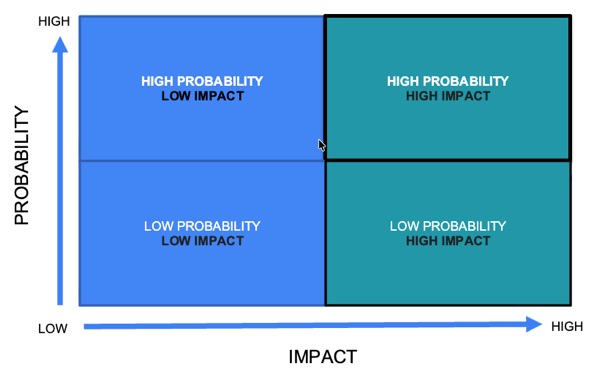The Risk Assessment Matrix is a fundamental (but scary) tool for evaluating and prioritising project risks based on two dimensions:
- Vertical Axis - Probability: How likely is this event to occur?
- Horizontal Axis - Impact: If this event does occur, how severe would the consequences be? Or, how much disruption would it cause?

As project manager, part of your job is to consider the potential risks and in which quadrant they belong. It’s helpful to already have a breakdown of your project deliverables and tasks before you start.
Let’s look at the four quadrants in turn:
The Four Quadrants
Bottom Left - Low Probability, Low Impact
- These are minor risks that are unlikely to happen and wouldn’t cause much disruption if they did.
- Generally require minimal attention or monitoring. They can be easily solved if they arise.
Top Left - High Probability, Low Impact
- These risks are likely to occur but won’t significantly derail your project.
- Often manageable through simple contingency plans or by building in small buffers or slack. Or, you might redesign your project to eliminate these risks altogether. This could save you the annoyance of some minor friction.
Bottom Right - Low Probability, High Impact
- These are the “catastrophic but unlikely” scenarios.
- Although you don’t want to spend too much time planning for an unlikely event, you should be monitoring for them. These scenarios are sometimes called “Black Swans”. A recent and vivid example is the Covid pandemic. This seemed vanishingly unlikely (to governments, if not to the research community), but it had a devastating impact. What would happen if you could no longer access the lab, archives, or travel on public transport? If you’re a PhD researcher, the departure of your primary supervisor might also belong in this quadrant.
Top Right - High Probability, High Impact
- This is the danger zone. It contains risks that are both likely to happen AND would cause serious problems 🙀
- These require your immediate attention and robust mitigation strategies. Catastrophising now is much easier than frantically finding a solution mid-project.
Using the Risk Assessment Matrix
Using a visual tool like the Risk Assessment Matrix helps you quickly identify which risks warrant your limited time and energy. Rather than treating all potential problems equally, you focus efforts on the High Probability, High Impact quadrant (while also keeping a nervous eye on the bottom right quadrant). You can distinguish between minor risks such as “participant drops out” versus “spiteful computer breaks during data analysis period”. What might be some early warning signs? For computers, it’s usually a strange whirring noise and increased obstinacy.
✅ Start by listing 5-10 potential risks for your current project, then plot them on the matrix.
Conclusion
Although the Risk Assessment Matrix won’t prevent disasters, the very process of identifying those risks makes some of them less likely to happen. Having increased your awareness, you’ll spot potential problems much earlier on in the project. Not having a plan is definitely a High Impact risk.
This resource is adapted from my Project Managing Your Research workshop.